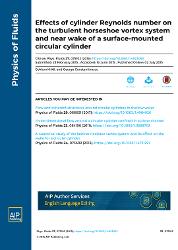| dc.contributor.author | Kirkil, Gökhan | |
| dc.contributor.author | Constantinescu, George | |
| dc.date.accessioned | 2019-06-27T08:02:16Z | |
| dc.date.available | 2019-06-27T08:02:16Z | |
| dc.date.issued | 2015 | |
| dc.identifier.issn | 1070-6631 | en_US |
| dc.identifier.issn | 1089-7666 | en_US |
| dc.identifier.uri | https://hdl.handle.net/20.500.12469/586 | |
| dc.identifier.uri | https://doi.org/10.1063/1.4923063 | |
| dc.description.abstract | The turbulent horseshoe vortex (HV) system and the near-wake flow past a circular cylinder mounted on a flat bed in an open channel are investigated based on the results of eddy-resolving simulations and supporting flow visualizations. Of particular interest are the changes in the mean flow and turbulence statistics within the HV region as the necklace vortices wrap around the cylinder's base and the variation of the mean flow and turbulence statistics in the near wake in between the channel bed and the free surface. While it is well known that the drag crisis induces important changes in the flow past infinitely long circular cylinders the changes are less understood and more complex for the case of flow past a surface-mounted cylinder. This is because even at very high cylinder Reynolds numbers Re-D the flow regime remains subcritical in the vicinity of the bed surface due to the reduction of the incoming flow velocity within the bottom boundary layer. The paper provides a detailed discussion of the changes in the flow physics between cylinder Reynolds numbers at which the flow in the upstream part of the separated shear layers (SSLs) is laminar (Re-D = 16 000 subcritical flow regime) and Reynolds numbers at which the transition occurs inside the attached boundary layers away from the bed and the flow within the SSLs is turbulent (Re-D = 5 * 10(5) supercritical flow regime). The changes between the two regimes in the dynamics and level of coherence of the large-scale coherent structures (necklace vortices vortex tubes shed in the SSLs and roller vortices shed in the wake) and their capacity to induce high-magnitude bed friction velocities in the mean and instantaneous flow fields and to amplify the near-bed turbulence are analyzed. Being able to quantitatively and qualitatively describe these changes is critical to understand Reynolds-number-induced scale effects on sediment erosion mechanisms around cylinders mounted on a loose bed which is a problem of great practical relevance (e.g. for pier scour studies). (C) 2015 AIP Publishing LLC. | en_US] |
| dc.language.iso | eng | en_US |
| dc.publisher | Amer Inst Physics | en_US |
| dc.rights | info:eu-repo/semantics/openAccess | en_US |
| dc.subject | N/A | en_US |
| dc.title | Effects of cylinder Reynolds number on the turbulent horseshoe vortex system and near wake of a surface-mounted circular cylinder | en_US |
| dc.type | article | en_US |
| dc.relation.journal | Physics Of Fluids | en_US |
| dc.identifier.issue | 7 | |
| dc.identifier.volume | 27 | en_US |
| dc.department | Fakülteler, Mühendislik ve Doğa Bilimleri Fakültesi, Endüstri Mühendisliği Bölümü | en_US |
| dc.identifier.wos | WOS:000358872200031 | en_US |
| dc.identifier.doi | 10.1063/1.4923063 | en_US |
| dc.institutionauthor | Kirkil, Gökhan | en_US |
| dc.relation.publicationcategory | Makale - Uluslararası Hakemli Dergi - Kurum Öğretim Elemanı | en_US |
















